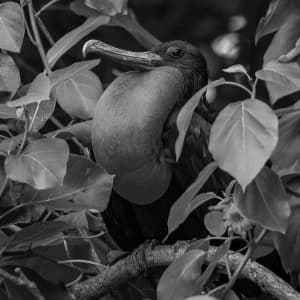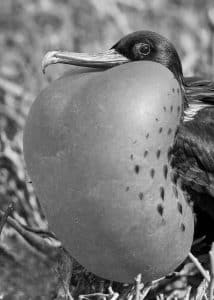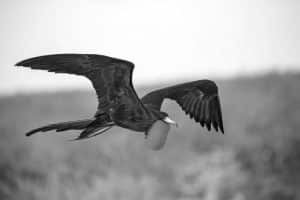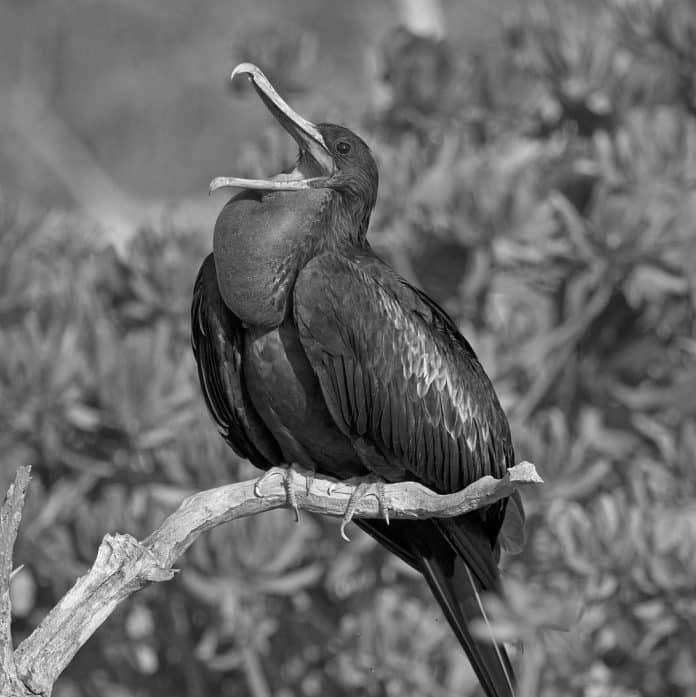Introduction to frigatebirds in Tanzania
Frigatebirds in Tanzania, scientifically known as Fregatidae, are a group of seabirds characterized by their large size, distinctive silhouettes, and exceptional flying skills. In Tanzania, several species of frigatebirds can be found, including the Great Frigatebird (Fregata minor) and the Lesser Frigatebird (Fregata ariel). These birds are often spotted along the Tanzanian coastline, soaring effortlessly above the turquoise waters of the Indian Ocean.
Characteristics and behavior of frigatebirds

Frigatebirds are easily recognizable due to their long, slender wings, deeply forked tails, and hooked bills. They have a wingspan that can reach up to 7.5 feet, allowing them to effortlessly glide through the air for extended periods. These birds are also known for their striking appearance, with males exhibiting a glossy black plumage and a distinctive red throat pouch that inflates during courtship displays.
In terms of behavior, frigatebirds are highly skilled aerial predators. They are known for their ability to snatch prey, such as fish and squid, from the ocean’s surface while in flight. Frigatebirds are also notorious for their kleptoparasitic tendencies, often harassing other seabirds, such as gulls and terns, to steal their freshly caught meals. This behavior has earned them the nickname “pirates of the sea.”
Habitat and distribution of frigatebirds in Tanzania
Frigatebirds in Tanzania are primarily found along the country’s coastal areas, particularly around the islands of Zanzibar, Pemba, and Mafia. These islands provide ideal nesting sites and feeding grounds for frigatebirds due to their proximity to the ocean and abundant marine life. Frigatebirds can also be observed near the mainland, especially in coastal regions such as Dar es Salaam and Tanga.
The distribution of frigatebirds extends beyond Tanzania, with populations found in other tropical and subtropical regions around the world. They are commonly seen in countries like Indonesia, Australia, and the Galapagos Islands. However, Tanzania offers a unique opportunity to witness these magnificent birds in their natural habitat, making it a popular destination for birdwatchers and wildlife enthusiasts.
Breeding and nesting habits of frigatebirds
Frigatebirds have unique breeding and nesting habits that set them apart from other seabird species. They form large breeding colonies on remote islands, where they create nests using twigs, leaves, and other natural materials. The nests are often built in trees or shrubs, providing protection from predators and favorable conditions for raising their young.
During the breeding season, male frigatebirds engage in elaborate courtship displays to attract females. They inflate their red throat pouches and spread their wings, creating a visually impressive spectacle. The females select their mates based on the size and coloration of the males’ throat pouches. Once a pair bonds, they engage in a monogamous relationship for the duration of the breeding season.
Feeding habits and diet of frigatebirds

Frigatebirds have adapted to a life of aerial foraging, relying on their exceptional flying skills to capture food. They primarily feed on fish, squid, and other small marine creatures found near the ocean’s surface. Unlike most seabirds, frigatebirds do not have waterproof feathers, which limits their ability to dive into the water for prey. Instead, they rely on their agility and speed to snatch food from the surface, often stealing from other birds through their kleptoparasitic behaviors.
To sustain their energy-intensive flight and metabolism, frigatebirds have a unique adaptation. They possess a highly efficient respiratory system that allows them to extract oxygen more effectively from the air. This adaptation enables them to remain airborne for extended periods without the need for frequent rest or landing.
Threats and conservation of frigatebirds in Tanzania
While frigatebirds are awe-inspiring creatures, they face several threats to their survival in Tanzania. One of the primary threats is habitat loss due to human activities, such as coastal development and deforestation. These activities disrupt nesting sites and reduce the availability of suitable feeding grounds for frigatebirds.
Additionally, frigatebirds are vulnerable to entanglement in fishing gear, especially when they attempt to steal fish from nets. This can result in injuries or even death for the birds. Climate change and pollution also pose significant challenges, impacting the availability of prey and altering the delicate ecosystems on which frigatebirds rely.
To protect frigatebirds and their habitats, various conservation efforts are underway in Tanzania. These initiatives focus on raising awareness, implementing sustainable fishing practices, and establishing protected areas where frigatebirds can nest and forage undisturbed. Tourism plays a crucial role in supporting these conservation efforts, as it generates funds for research, habitat restoration, and community education programs.
Best locations for observing frigatebirds in Tanzania
For those eager to witness the breathtaking flight of frigatebirds in Tanzania, several locations offer excellent opportunities for observation. The islands of Zanzibar, Pemba, and Mafia are particularly renowned for their frigatebird populations. Visitors can embark on boat tours or join guided birdwatching expeditions to witness these majestic birds in their natural habitat.
Additionally, coastal regions such as Dar es Salaam and Tanga provide ample opportunities for frigatebird sightings. These areas offer a mix of urban convenience and natural beauty, allowing visitors to enjoy the vibrant culture of Tanzania while immersing themselves in the wonders of avian life.
Tips for photographing frigatebirds in flight
Capturing the grace and beauty of frigatebirds in flight can be a rewarding experience for photographers. Here are some tips to enhance your chances of capturing stunning images:
- Use a fast shutter speed: Frigatebirds are incredibly agile and fast in flight. To freeze their motion and capture sharp images, opt for a fast shutter speed, preferably above 1/1000th of a second.
- Utilize burst mode: Frigatebirds’ flight patterns can be unpredictable, making it challenging to anticipate the perfect shot. Set your camera to burst mode to capture a series of images in quick succession, increasing your chances of capturing the ideal moment.
- Pay attention to composition: Consider the background and foreground elements when framing your shot. Look for contrasting colors or interesting patterns to create visually striking compositions.
- Experiment with different angles: Don’t limit yourself to shooting frigatebirds from eye level. Explore different perspectives by shooting from low angles or capturing their flight from above, adding variety and dynamism to your photographs.
- Be patient and observant: Frigatebirds exhibit various behaviors during flight, such as soaring, diving, and interacting with other birds. Observe their patterns and anticipate their movements to capture unique and captivating moments.
Joining a birdwatching tour to see frigatebirds in Tanzania

If you’re passionate about birdwatching and want to make the most of your frigatebird experience in Tanzania, joining a birdwatching tour is highly recommended. These tours are led by experienced guides who possess extensive knowledge of the local bird species and their habitats. They can take you to the best frigatebird hotspots, ensuring you have optimal opportunities for observation and photography.
Birdwatching tours also offer the opportunity to learn about the conservation efforts aimed at protecting frigatebirds in Tanzania. By joining a tour, you contribute directly to these initiatives, supporting the local communities and organizations dedicated to preserving the country’s avian treasures.
Conclusion: The beauty and importance of frigatebirds in Tanzania’s ecosystem
Frigatebirds are truly the masters of the Tanzanian skies. Their exceptional flight abilities, striking appearance, and captivating behaviors make them a sight to behold. These magnificent seabirds play a vital role in Tanzania’s ecosystem, contributing to the delicate balance of the marine environment.
As we explore the world of frigatebirds in Tanzania, it becomes evident that their conservation is of utmost importance. By understanding their characteristics, habitat, breeding habits, and feeding behaviors, we can appreciate their significance and actively contribute to their protection. Whether through responsible tourism, supporting conservation initiatives, or simply sharing knowledge, we can ensure that these majestic birds continue to grace the Tanzanian skies for generations to come.


































